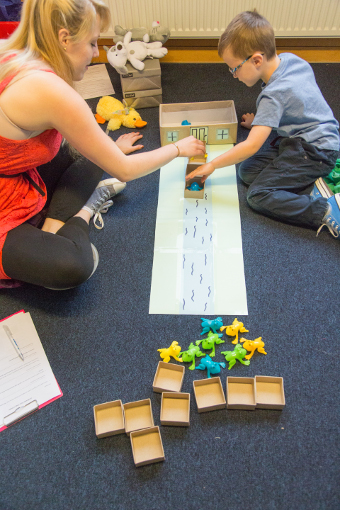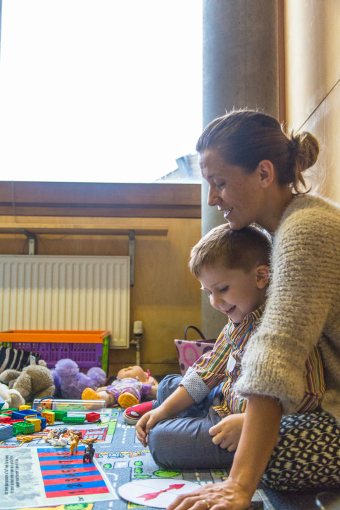Maths, Language and Learning
Marvellous Maths and Memory
Working memory is a mental 'post-it note' that we can use to store and manipulate information. It has been found to be important for learning maths at school.
In this game we were interested in how working memory is involved in learning and remembering mathematical facts, such as times tables. We asked children aged between 7 and 11 years to learn some new 'alien arithmetic' facts. We also measured their working memory by asking them to remember lists of animals of increasing length, first repeating the lists forwards, and then backwards.
There was a lot of variation between the children in how many new maths facts they learned, with some children learning the new sums very easily while others struggled and only learned one or two. Our initial analyses suggested that this was related to how good a child’s working memory was, such that children with better working memory were able to learn more of the new sums.
However, follow-up analyses suggested that how old the child was and how good their vocabulary was (as measured by the 'What’s that word?' game) were better predictors of how well the children could learn the sums.
Party Animals
Children start learning about maths even before they start school, although some find this easier than others. There are several basic number skills that might be important for early maths learning. We asked four and five year-old children to play three animal-themed number games to explore these different skills.
In one game children had to decide which of two animals had the most sweets. The number of sweets were presented in different formats: verbal number words (e.g. 'five') and visual pictures (e.g. five dots on a card). This game measured children’s ability to make connections between different representations of number.
In another game children were told a story about frogs going to a party in boats. They were then asked questions about the numbers of frogs and numbers of boats required. This measured children’s understanding of cardinality - the amount of elements in a set. In a third game, children were asked to complete a short arithmetic activity. This measured counting, addition and subtraction skills.
We found that children who scored highly on the "Who has the most sweets?" game also did well on the frog game and the arithmetic activity. This tells us that children’s ability to connect different representations of number and their understanding of cardinality (amount) are two important skills for early maths learning.
Next, we will investigate which of these skills is the most important predictor of early mathematics success.

See it and say it
Together with formal learning in school, children learn a lot by observing the world around them. This informal learning can help children as they develop skills across lots of subject areas. In this game we investigated children’s natural tendency to notice numbers in the world around them. We were looking to see how this tendency to notice numbers relates to children’s formal numerical skills.
We asked six to nine year-old children to describe some pictures and we noted whether or not they used number in their descriptions (e.g. 'there are three houses'). Children also completed some puzzles with written sums and number word problems.
On the picture task we found differences in children’s descriptions. Whilst some children focused on number, others focused on the colours or the emotional content of the pictures. We found that children who noticed numbers on the picture task also did better on the arithmetic puzzles. One explanation for this is that children who are more naturally inclined to notice numbers get more practice using their numerical skills in the world around them.
These findings help us to understand the link between children's informal use of numbers and their formal numerical development.
Let's play!
Before starting school, children can learn about numbers from their parents at home. This can lead to improvement in children’s maths performance when starting school. Understanding the different home environments in which children are exposed to numbers may help us to improve children’s early learning of mathematics.
In this game, we investigated the variety of activities parents and children mention number in and the frequency of number activities in the home.
Four-year-old children and their parents were invited to play together with three different activities (building with Lego, playing a board game and reading a book). Each session was video-recorded and we recorded how parents and children used numbers. We also asked the children to do some quick maths activities while parents completed a questionnaire on the amount of number activities they did with their child at home.
This study is still continuing, with more parents and children taking part. We are expecting that the more number activities parents do with their child at home and the more activities parents mention number in, the better the children’s performance on the maths activities.
The results from this study will help us to understand what is important in improving children’s maths performance: amount of activities at home, or variety of activities in which parents mention numbers.

Words, words, words
Our study looked at how children learn words for different objects. For decades, it has been suggested that monolingual children (who only speak one language) don’t like learning a second name for an object they already know. While it explains some aspects of the way children learn new words, it also implies that children may have difficulties learning another word with the same meaning, or words in another language.
To evaluate this suggestion, in our study children first heard a new word while seeing a new and a familiar object, in a phase called 'practice'. Then, they were asked to match the novel word with one of two novel pictures, one of them seen during practice (we call this the 'novel' test). Finally, children were asked to match the novel word with one of two familiar pictures, again with one of them seen during practice ('familiar' test).
We found that, in practice, children selected the novel object when they heard the new word. In the 'novel' test, they selected the matching novel objects, regardless of the age groups, thereby suggesting they learnt the new word for the new object. We also found that children older than seven years old selected the matching familiar object in 'familiar' test trials, when they heard the new word.
This suggests that children can learn many words for the same object, even though they were more accurate when learning a new word for a new object than learning a second word for a familiar object. This suggests that children may possess an initial bias to learn one word for one object. Then, monolingual children will also start accepting multiple words for the same objects, imitating their bilingual peers.